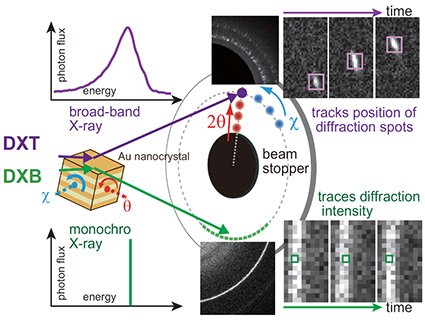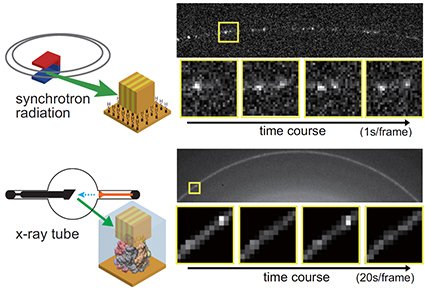Press Release
Successful Observations of the Dynamic of Single Molecules with Amazing Low X-ray Doses
- News
- Press Release
◆ We succeeded in time-resolved observations of hyper-fine motion of gold nanocrystals-labeled individual single molecules using monochromatic X-rays from a synchrotron radiation facility and a laboratory X-ray source.
◆ The data could be measured with an X-ray exposure as low as 1/1700 when compared to the conventional Diffracted X-ray Tracking (DXT) method, and when using a laboratory light source, it could be measured with an exposure amount of 1/500000. In addition, by alleviating X-ray damage, it has become possible to observe individual single molecule motions with X-rays in living cells.
◆ Since the exposure dose stays very small, various developments are expected, such as measurement with even less damages, long-term observations, simultaneous measurements of labeled nanocrystals having various lattice constants.
Presentation summary:
In recent years, the observation of single protein molecules has made a phenomenal development, and it has become possible to observe molecular dynamics in-vivo at high-speed and with high accuracy. In the conventional DXT (Diffracted X-ray Tracking), by labeling with a gold nanocrystal a specific site of a target protein molecule, and by observing the positional change of the diffracted X-ray spots from the labeled gold nanocrystal with time-resolution of micro-second and pico-meter precision, we could successfully measure the internal motions of single molecules using DXT.
Professor Yuji C. Sasaki of from the University of Tokyo, his japan research group and Dr. L.M.G. Chavas of from the French Synchrotron SOLEIL have succeeded in a new X-ray diffraction experiment using monochromatic X-rays at a synchrotron radiation facility. They confirmed the blinking phenomenon due to the motions of labeled gold nanocrystals for the first time in the world, and showed that by analyzing autocorrelation, it is possible to quantitatively evaluate the motion velocity of diffracted X-ray spots. In the new single molecule observation method, that we called Diffracted X-ray Blinking (DXB, Fig.1), using this monochromatic X-rays, when compared with DXT, which can record internal monomolecular dynamics, X-ray exposure of 1 / 1,700 was necessary and sufficient. Therefore, by using the diffracted X-ray blinking observation as shown in Fig.2, it is possible to perform dynamic observations of a single molecule with an amazing low X-ray dose. Furthermore, we also demonstrated that it is possible to measure single molecule motions on a laboratory X-ray source at the millisecond level utilizing this low exposure characteristic. This paper will be published in Scientific Reports on 30th November.
DOI: 10.1038/s41598-018-35468-3
URL:www.nature.com/articles/s41598-018-35468-3

Fig.1: Difference in principle of DXT (Diffracted X-ray Tracking) and DXB (Diffracted X-ray Blinking). In two methods, important analytical factors are changed from position information of the X-ray diffraction spots to its intensity information. This greatly contributes to the development of quantitative analysis technology of high sensitivity X-ray detector.

Fig.2: An X-ray blinking phenomenon (diffracted X - ray blinking) was found in this
paper. An example using monochromatic X-rays from synchrotron radiation and an
example using monochromatic X-rays from laboratory X-ray are shown. Both of them
confirmed a clear blinking phenomenon and proposed the world's first simple
interpretation.
